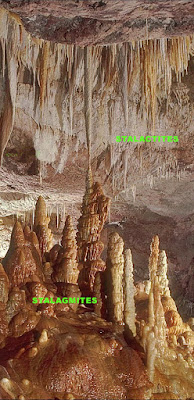My previous post concerns the topics of groundwater and water table, both of which are crucial in understanding the present topic.
In limestone terrains, when rain water, which has become acidic by interacting with decaying plant matter, percolates into the ground and goes into the water table, water-filled caves are created in the limestone. If the water table drops during a drought, then these caves become air-filled areas with dripping water that forms stalactites on the ceilings of the caves and stalagmites on the opposite floor directly below.
The image above is from Wikipedia.org. No location or a scale were given.
Stalactites and stalagmites consist of layers (rings) of polycrystalline aggregates of calcium carbonate, which is the material that makes up limestone.
Cross section of a stalactite or a stalagmite (7 cm diameter). Most of the surface is encrusted, but underneath the encrustation, the growth layers are visible. Locale unknown.
The next three views show the side views of the same hand specimen:
Left side (7 cm across). You can see the "popcorn" structure of the calcium-carbonate deposits,
Next side (5.5 cm) across. The "popcorn" structure dominates this surface.
The "back side" (7 cm wide) of the specimen, showing annulations but no "popcorn.'
Cave "popcorn,' also called coralloids, consists of small nodes of calcite or aragonite that form when water fills the pores in these minerals and then air flows over the surface. Caves with "popcorn" are big, wet, and breezy (e.g., South Dakota's Black Hills region).
If you go back and look at the images, you will see that the internal structure of this hand specimen has no "popcorn." The"popcorn" occurs only on one side although the beginnings of it begin on the reverse side. I conclude, therefore, that this stalactite or stalagmite had a relatively dry beginning, followed by a time when the cave-environment became wetter and also experienced breezy conditions that were unidirectional (causing the "popcorn" to form on the down-wind side). The annulations on the other side show that the wind affected that side also, but the water was blown along the sides of the column and accumulated on only one side, where the calcite nodules formed.
Stalactites and stalagmites grow extremely slowly, usually less than 10 cm (4 in.) every thousand years. The largest known stalagmite is 8.2 m (27 ft.) long. It is in "The White Chamber" of the Jeita Grotto in Lebanon.







No comments:
Post a Comment